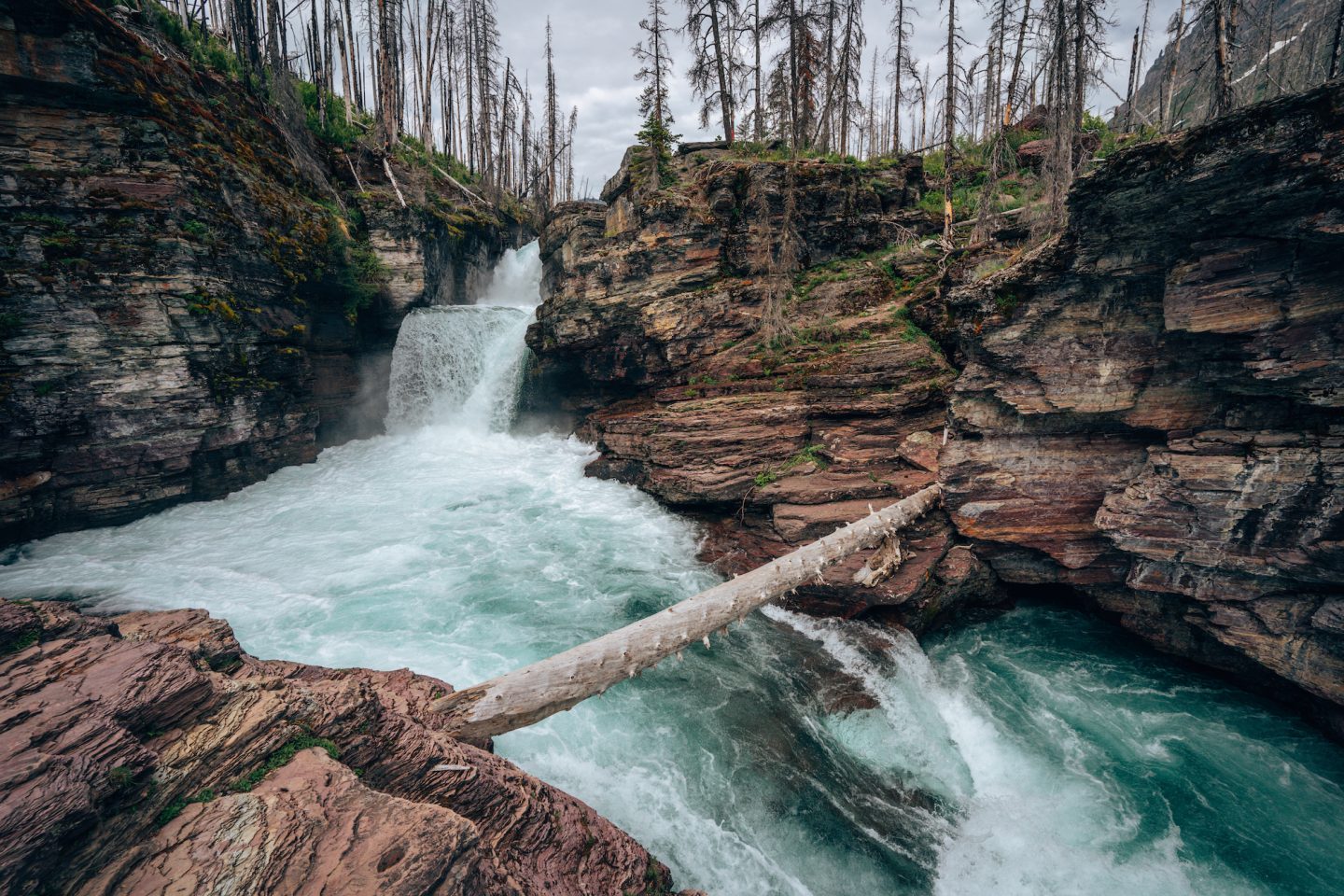
Hey there, soft adventurers! Welcome to Glacier National Park. A breathtaking gem nestled in the heart of the Rocky Mountains of Montana in the United States. Known for awe-inspiring landscapes, pristine alpine lakes, and rugged wilderness. This natural wonderland captivates visitors with its majestic snow-capped peaks, sprawling glaciers, and abundant wildlife. So whether you’re seeking serenity surrounded by nature, or epic adventures to jaw-dropping landscapes, Glacier National Park has it all. So, gear up, lace your boots, and get ready for an unforgettable journey as we dig in to this ultimate guide to Glacier National Park in Montana!
ABOUT GLACIER NATIONAL PARK
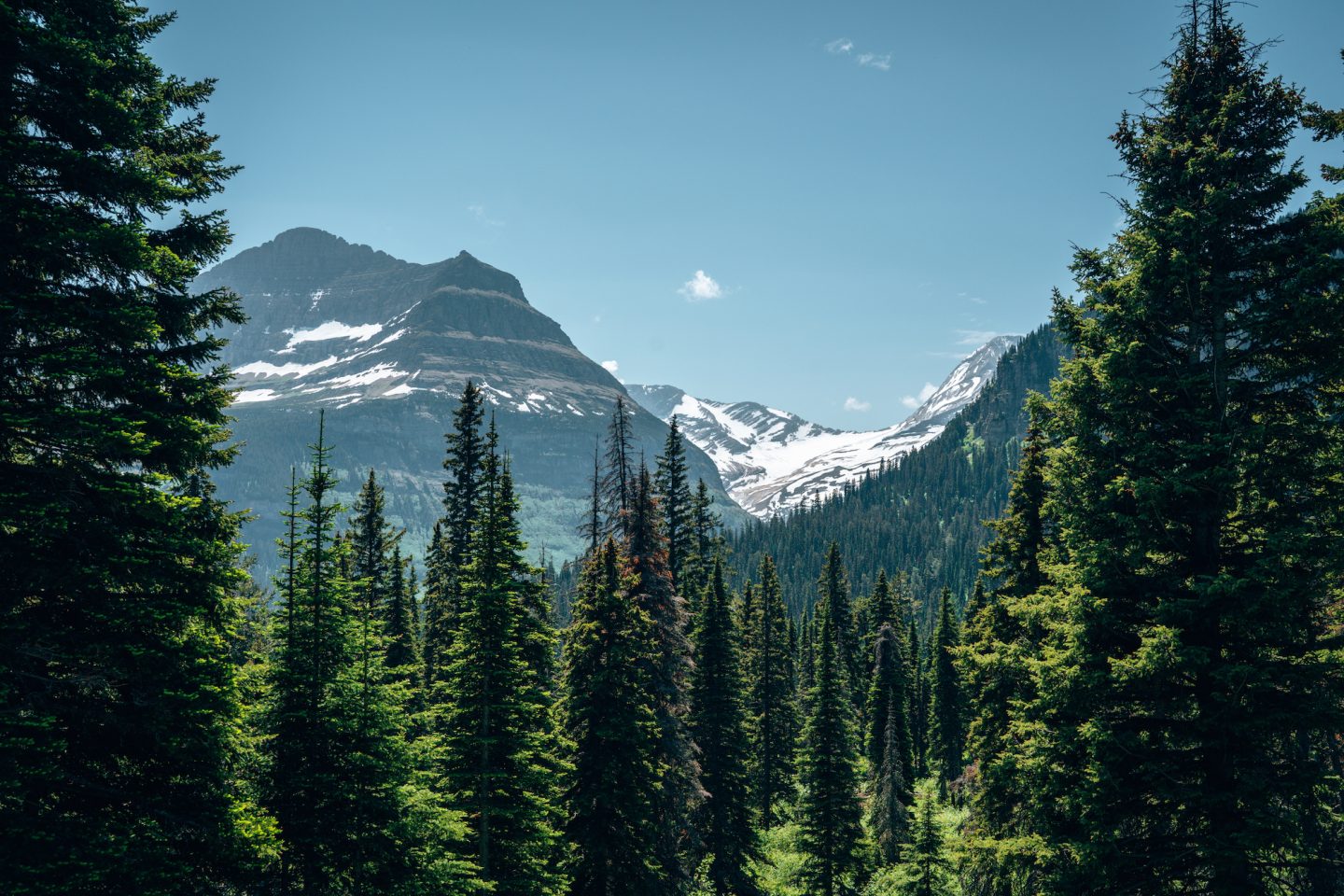
HOW THE LANDSCAPE WAS FORMED
The breathtaking landscape of Glacier National Park is the result of millions of years of geological processes that have shaped and sculpted the terrain. It all began during the last Ice Age, approximately 2 million years ago. Immense glaciers crept across the landscape, gouging deep valleys and leaving behind towering peaks. As the glaciers advanced and retreated, they carved out impressive U-shaped valleys, creating the iconic fjords and hanging valleys that define the park’s rugged beauty today.
Over time, the glaciers eroded the surrounding rock, grinding it into fine glacial sediment known as moraine, which now forms the park’s fertile valleys and lush alpine meadows. The slow but steady movement of these glaciers also helped create the crystal-clear glacial lakes that dot the landscape, adding to the park’s picturesque charm.
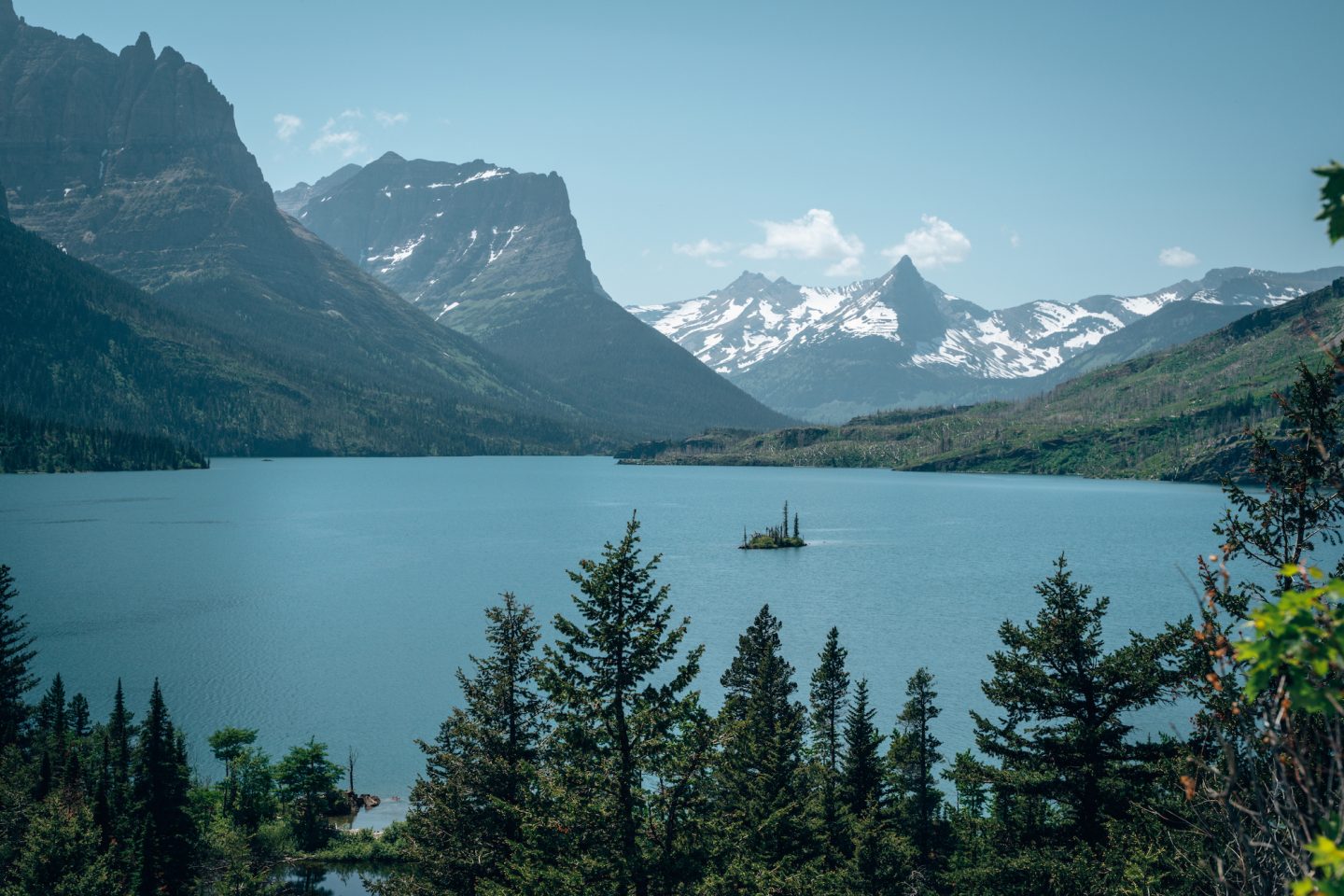
As the Ice Age waned, the glaciers receded, leaving behind an awe-inspiring landscape of deep valleys, sharp arêtes, and stunning cirques. The vast ice sheets that once dominated the region have now been reduced to a few surviving glaciers. Each serving as a living testament to the dynamic forces that continue to shape Glacier National Park today. From the powerful forces of glacial erosion to the slow dance of sedimentation, this remarkable park stands as a living geological textbook. Offering a window into the Earth’s transformative past and an enduring tribute to the majesty of natural processes.
HISTORY OF THE PARK
The history of Glacier National Park is as rich and captivating as the landscapes it encompasses. Long before becoming a designated national park, this pristine wilderness was inhabited by various Indigenous peoples. Including the Blackfeet, Salish, Kootenai, and Pend d’Oreille tribes. For centuries, these Native American communities revered and respected the land, weaving deep cultural connections with its abundant resources and majestic vistas.
In the late 19th century, European explorers and settlers began to venture into the region, enticed by stories of its natural wonders. In the late 1800s and early 1900s, the Great Northern Railway, led by visionary entrepreneur James J. Hill, played a crucial role in promoting tourism to the area. Hill’s “See America First” campaign sought to attract visitors to the rugged beauty of the West, including Glacier’s awe-inspiring landscapes. The development of the railway system, combined with the promotion of Glacier as a destination, led to an influx of tourists eager to experience the untouched wilderness.
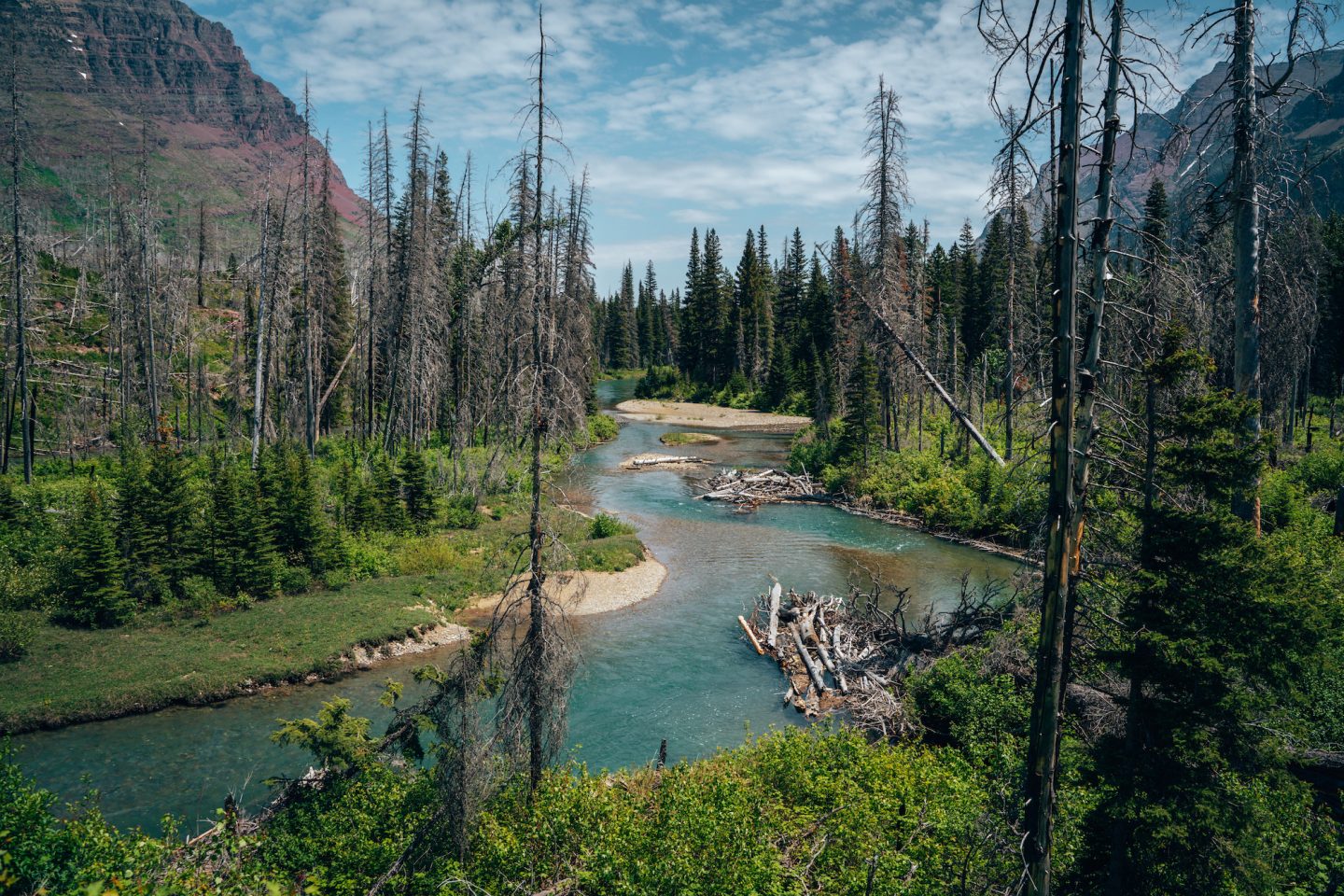
PARK ESTABLISHMENT
The official establishment of Glacier National Park occurred on May 11, 1910, when President William Howard Taft signed the bill into law, making it the 10th national park in the United States. However, it wasn’t until 1932 that the park’s boundaries were expanded to encompass over a million acres of pristine wilderness, including the adjoining Waterton Lakes National Park in Canada, forming the world’s first International Peace Park. Today, Glacier National Park stands as a testament to the dedication of early conservationists, preserving its unique ecosystems, glaciers, and wildlife for future generations to marvel at and cherish. The park continues to inspire visitors from around the world, drawing them into a journey through time and nature’s grandeur, where the echoes of history and the timeless beauty of the wilderness converge in a symphony of wonder.
WHERE IS GLACIER NATIONAL PARK LOCATED?
Glacier National Park is located in the northwest corner of Montana, United States. Situated along the border with Canada, the park extends into the Canadian province of Alberta, where it joins with Waterton Lakes National Park to form the Waterton-Glacier International Peace Park, a designated UNESCO World Heritage Site. In fact, in West Glacier just outside the West Glacier Entrance to the park, is an Alberta Visitors Centre for Waterton Lakes National Park.
The park’s northern boundary is defined by the international border between the United States and Canada, while its southern boundary is marked by the iconic Going-to-the-Sun Road, a scenic highway that offers breathtaking views of the park’s stunning landscapes. Glacier National Park is easily accessible, with several entrances providing entry points to the vast wilderness and abundant natural wonders that await adventurous visitors.
DRIVE TIME FROM:
Drive time is largely dependent on what area of the park you are heading to, so these drive times are general averages. Please double check the area you’re heading to in advance, as some roads may lead to longer drive times.
- Missoula – 3 hours
- Calgary – 5 hours
- Spokane – 5 hours
- Billings – 7 hours
- Seattle – 8.5 hours
- Salt Lake City – 9.5 hours
- Portland – 10 hours
- Boise- 10 hours
CLOSEST AIRPORT
The closest international airport to Glacier National Park is Calgary International Airport (YYC), located in Calgary, Alberta, Canada. While it is not as close as Glacier Park International Airport (FCA) in Kalispell, Montana, it is the nearest major international airport for visitors coming from outside of North America.
MAP OF THE GLACIER NATIONAL PARK
ENTRY TO GLACIER NATIONAL PARK
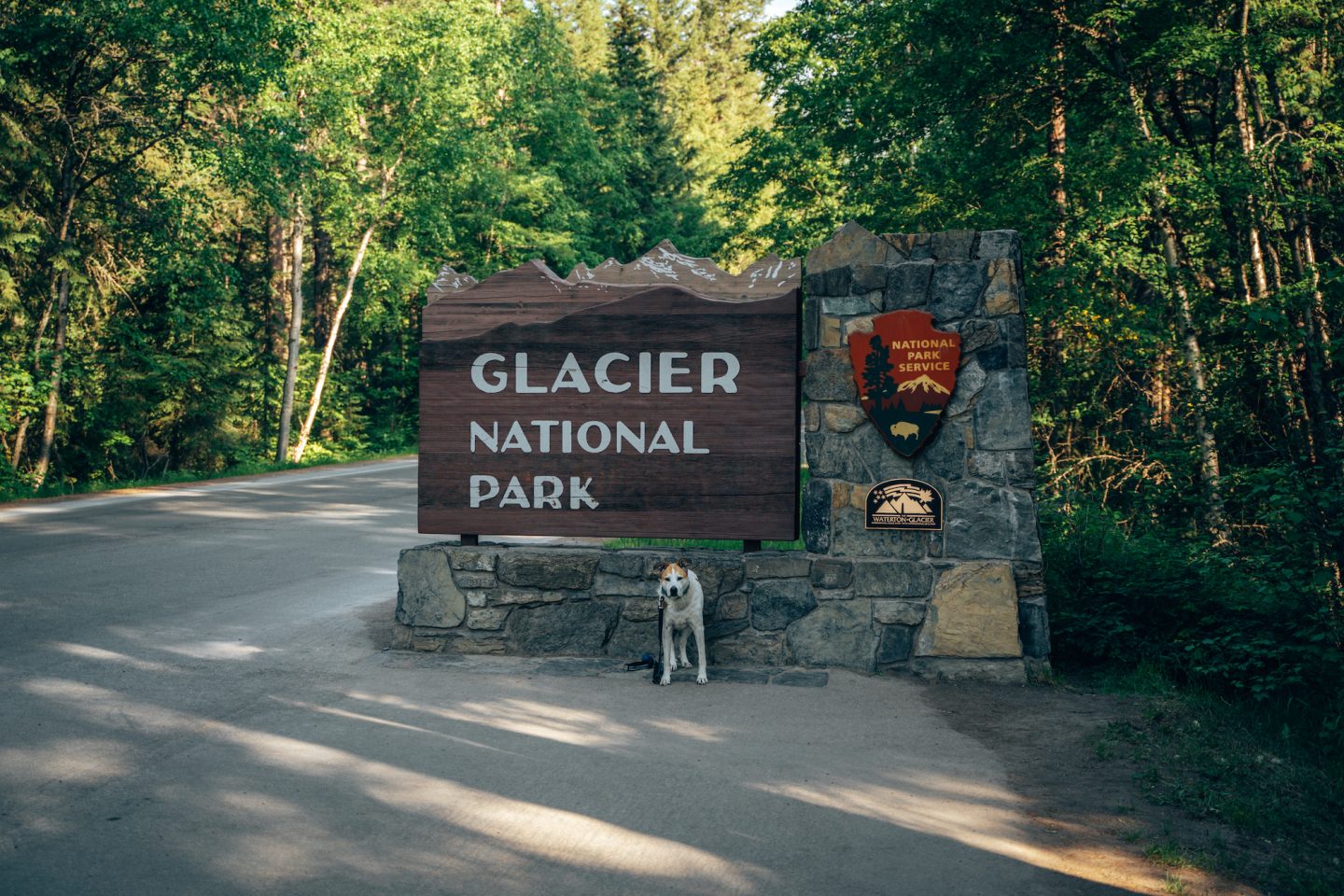
ENTRANCE FEES
For 2023, Glacier National Park implemented a reservation system for different areas of the park throughout the summer months. This was largely due to ongoing construction of Going-To-The-Sun Rd. Before planning or visiting the park, we’d highly recommend checking the NPS website to confirm current entry requirements and road closures.
Glacier National Park has a standard fee of $35 per vehicle, which is good for 7 days, no matter the time of year you are visiting. If you are someone who lives in Montana or the neighboring areas, and would like to visit Glacier National Park often, they do have a $35 annual pass that you can get as well. You can view all the entry and pass options HERE. That being said, for an extra $10, you can get the America The Beautiful Annual Pass.
If you are someone like us who is either on a mission to visit every single National Park in the U.S., or plans to visit more than 2 or 3 U.S. national parks per year, then we’d highly recommend getting the America The Beautiful Pass. For $80, this annual pass gives you full access to all 63 National Parks in the U.S., as well as any federal recreational sites that charge a fee for entry. Stay at 3 National Parks and this easily pays for itself.
VISITORS CENTERS
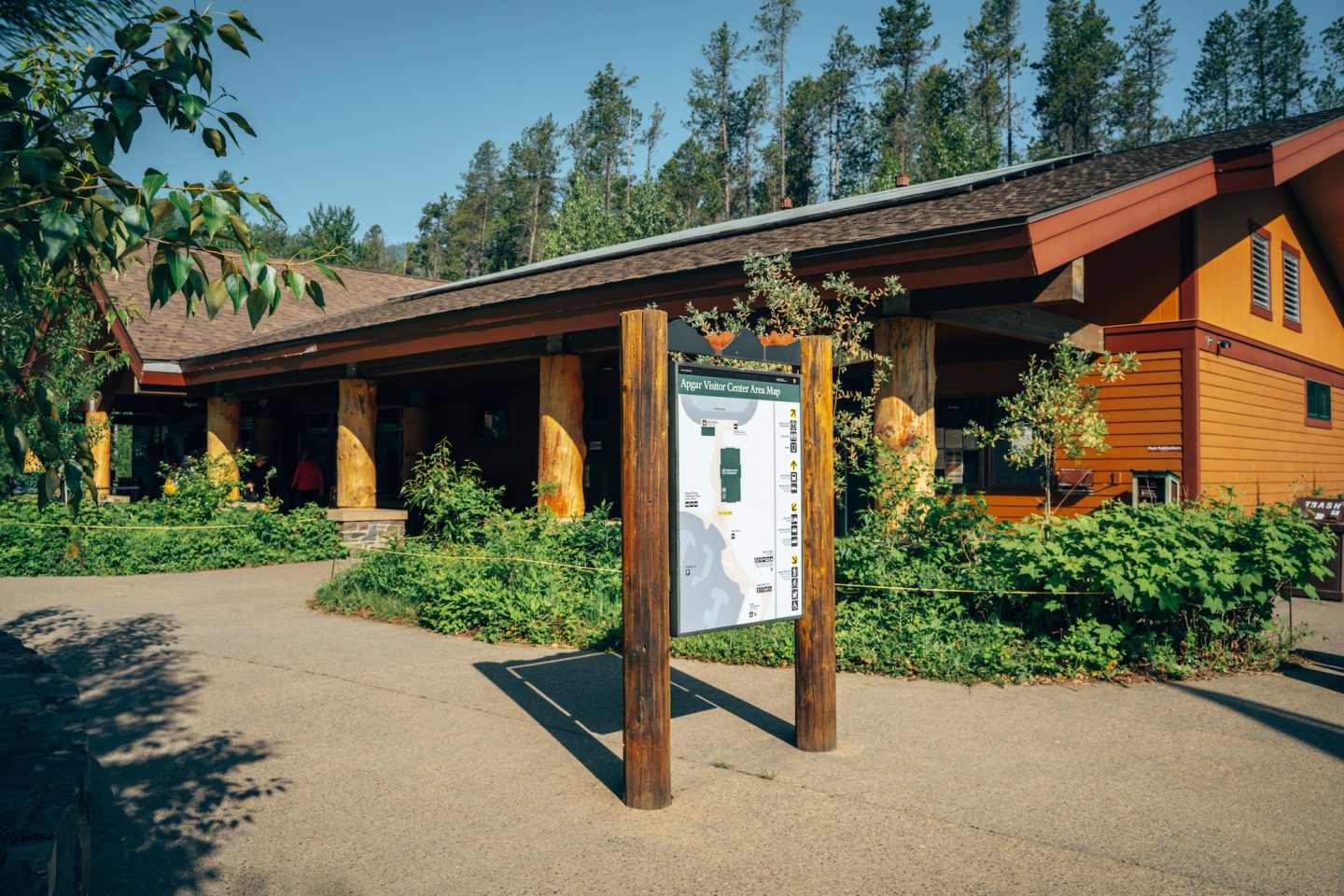
There are three visitors centers inside the park:
- St. Mary Visitor Center (East)
- Apgar Visitor Center (West)
- Logan Pass Visitor Center (Center)
Each visitor center has staff on hand to provide information, recommendations, maps and guides, as well as bookstores to get all your Glacier National Park souvenirs!
Check our map above to see where each of the visitor centers are and which might be the best to visit during your trip!
WHERE TO STAY IN GLACIER NATIONAL PARK
Inside Glacier National Park, visitors have the unique opportunity to immerse themselves in the park’s beauty by staying at one of its historic lodges, rustic cabins, or campgrounds. Whether waking up to the serene beauty of glacial lakes or falling asleep beneath a canopy of stars, staying inside Glacier National Park offers an unparalleled connection with nature that will leave visitors with cherished memories of their journey.
CAMPGROUNDS
Glacier National Park offers a range of picturesque campgrounds, allowing visitors to immerse themselves in the park’s natural beauty and enjoy a truly authentic outdoor experience. One of the popular campgrounds is Apgar Campground, situated near the west entrance of the park and offering easy access to Lake McDonald. Its convenient location makes it a great base for exploring the western side of Glacier.
Rising Sun Campground, located along the Going-to-the-Sun Road on the east side of the park, provides stunning views of St. Mary Lake and is an ideal spot for early risers looking to catch the sunrise over the dramatic landscape.
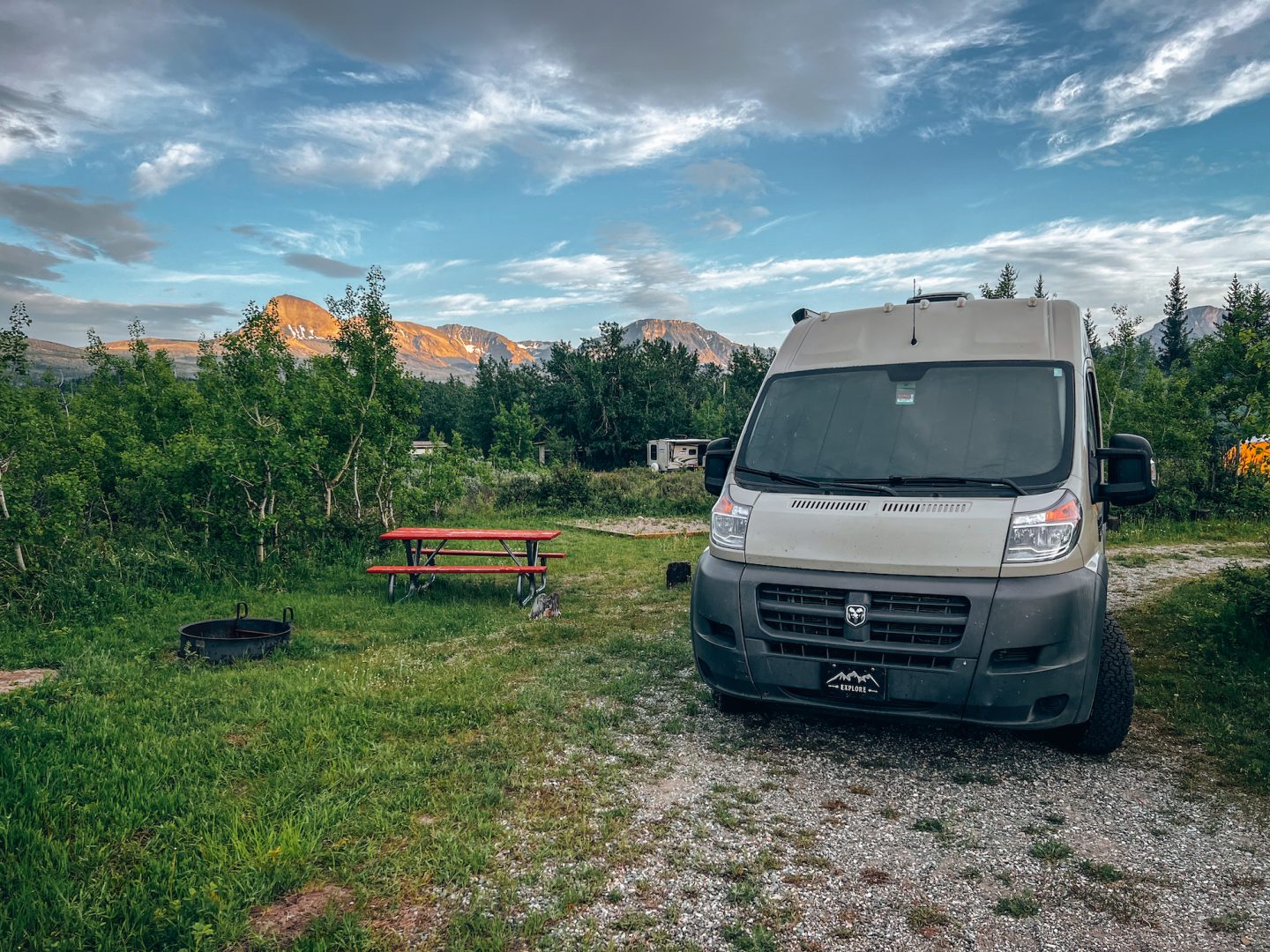
For a more remote camping experience, Two Medicine Campground in the southeastern part of the park offers a serene setting near Two Medicine Lake and access to a variety of hiking trails.
Additionally, many campgrounds operate on a first-come, first-served basis, so it’s essential to arrive early during peak seasons to secure a spot. Keep in mind that camping in Glacier National Park is an extraordinary way to connect with nature and relish in the park’s raw beauty, but campers should always follow Leave No Trace principles to help preserve this precious wilderness for generations to come.
HOTELS & LODGES
Among the most iconic accommodations is the historic Many Glacier Hotel, located on the shores of Swiftcurrent Lake. Offering stunning views of surrounding peaks, this grand Swiss-style lodge exudes old-world charm and provides an unforgettable experience. For those seeking a cozy retreat, the Lake McDonald Lodge, nestled on the shore of its namesake lake, offers a warm and welcoming ambiance. Additionally, rustic cabins and backcountry chalets, such as the Sperry Chalet and Granite Park Chalet, provide adventurous travelers a chance to stay closer to the heart of the park’s rugged wilderness.
Whether waking up to the serene beauty of glacial lakes or falling asleep beneath a canopy of stars, staying inside Glacier National Park offers an unparalleled connection with nature that will leave visitors with cherished memories of their journey.
You can learn more about places to stay in Glacier National Park in Montana HERE.
HARVEST HOST
Do you have a RV or a camper? Then Harvest Hosts is easily the best $100 spent. Harvest Host is a network of over 2,500 locations around the U.S., Canada and Mexico that allow you to stay at overnight at no additional cost*. The best part? These locations are wineries, breweries, distilleries, farms, museums and more! Imagine opening the door to your camper or RV to morning views over a vineyard. Or sipping delicious beer at a local brewery. This is the life you could be living. So if you aren’t already a member, trust us, click here and sign up!
*It is highly recommended and encouraged to spend at least $20 when staying at a winery, brewery, or distillery to help support the business
BLM AND FREE CAMPING SPOTS
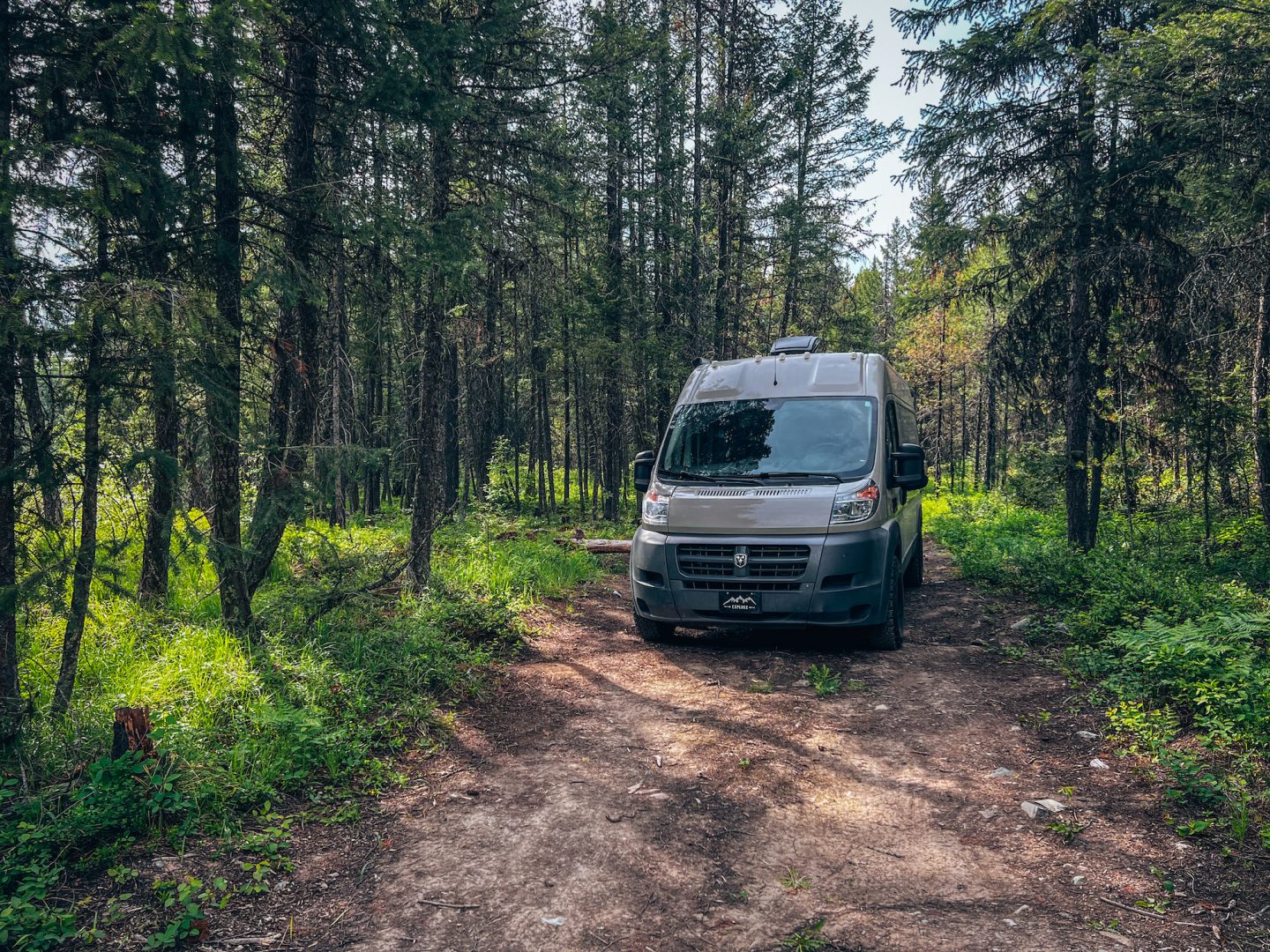
If you’re a van lifer, or someone who would prefer to spend time on free land outside the park, we have good news! There are a number of locations just outside the park that offer free dispersed camping making it easy to get in and out of the park. Make sure to take a look at our map above for exact locations.
THINGS TO DO IN GLACIER NATIONAL PARK
GOING-TO-THE-SUN ROAD
One of the best ways to experience the grandeur of Glacier National Park is by taking scenic drives along iconic roads like the Going-to-the-Sun Road, offering breathtaking views of glaciers, waterfalls, and rugged mountains. Going-to-the-Sun Road runs from West Glacier, through Logan Pass to St. Mary, and vice versa. Don’t miss the opportunity to stop at Logan Pass and Many Glacier Road for additional stunning overlooks.
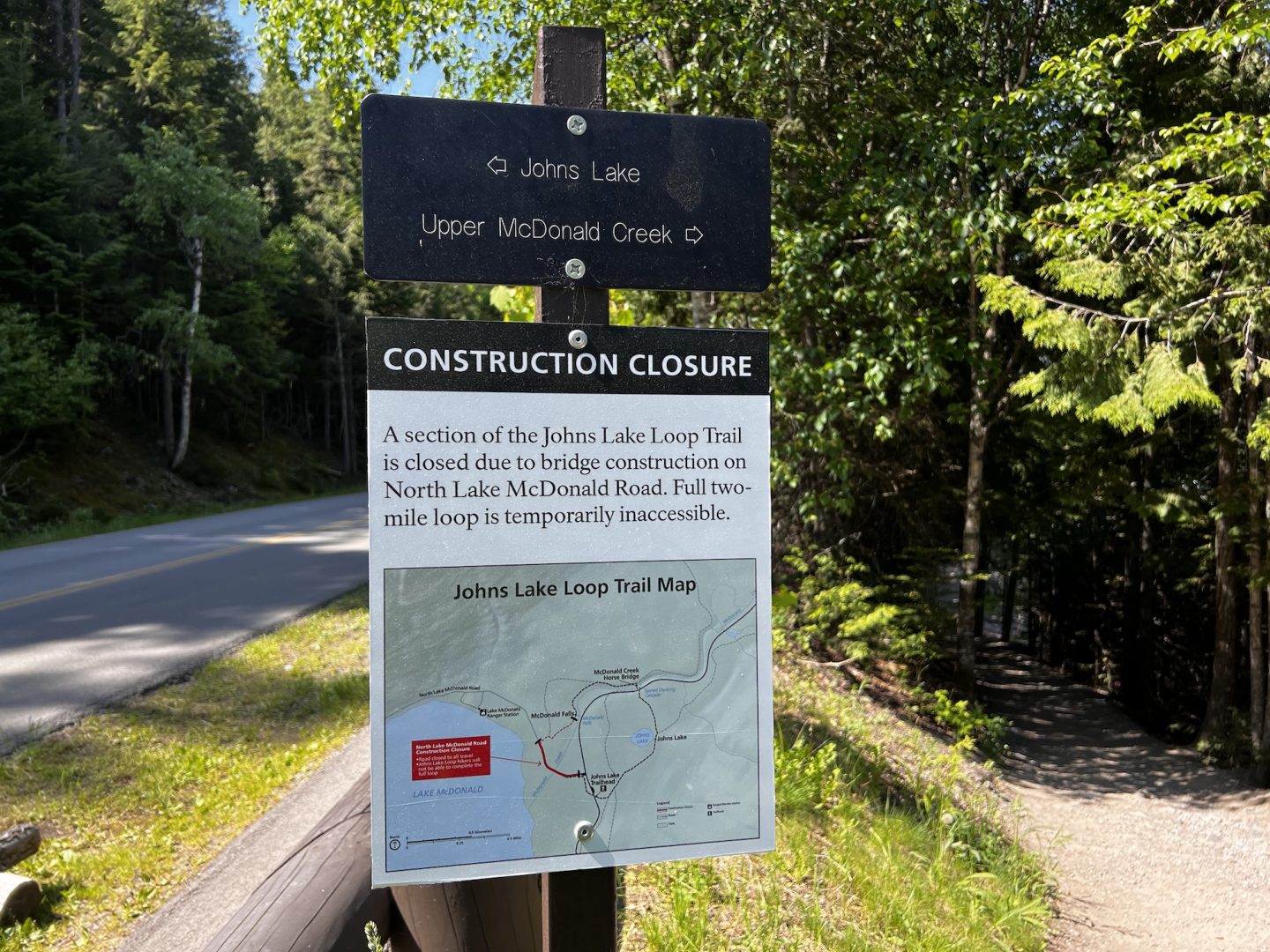
*As of writing this in 2023, a section of Going-to-the-Sun Road between west and east Glacier, is closed off for construction. Make sure to check the NPS website for road closure info!
HIKES
Lace up your hiking boots and hit the park’s numerous trails. Whether you’re a soft adventurer like us, or someone looking for those more challenging hikes, there are trails with incredible views for you. And each trail offers a unique perspective and showcases the park’s natural beauty up close.
ROCK POINT TRAIL
Rock Point Trail is a short and easy hidden gem of a trail, located on the eastern shore of Lake McDonald, offers visitors a delightful experience with minimal effort. The trailhead begins near the Rising Sun boat dock, making it easily accessible for all ages and abilities.
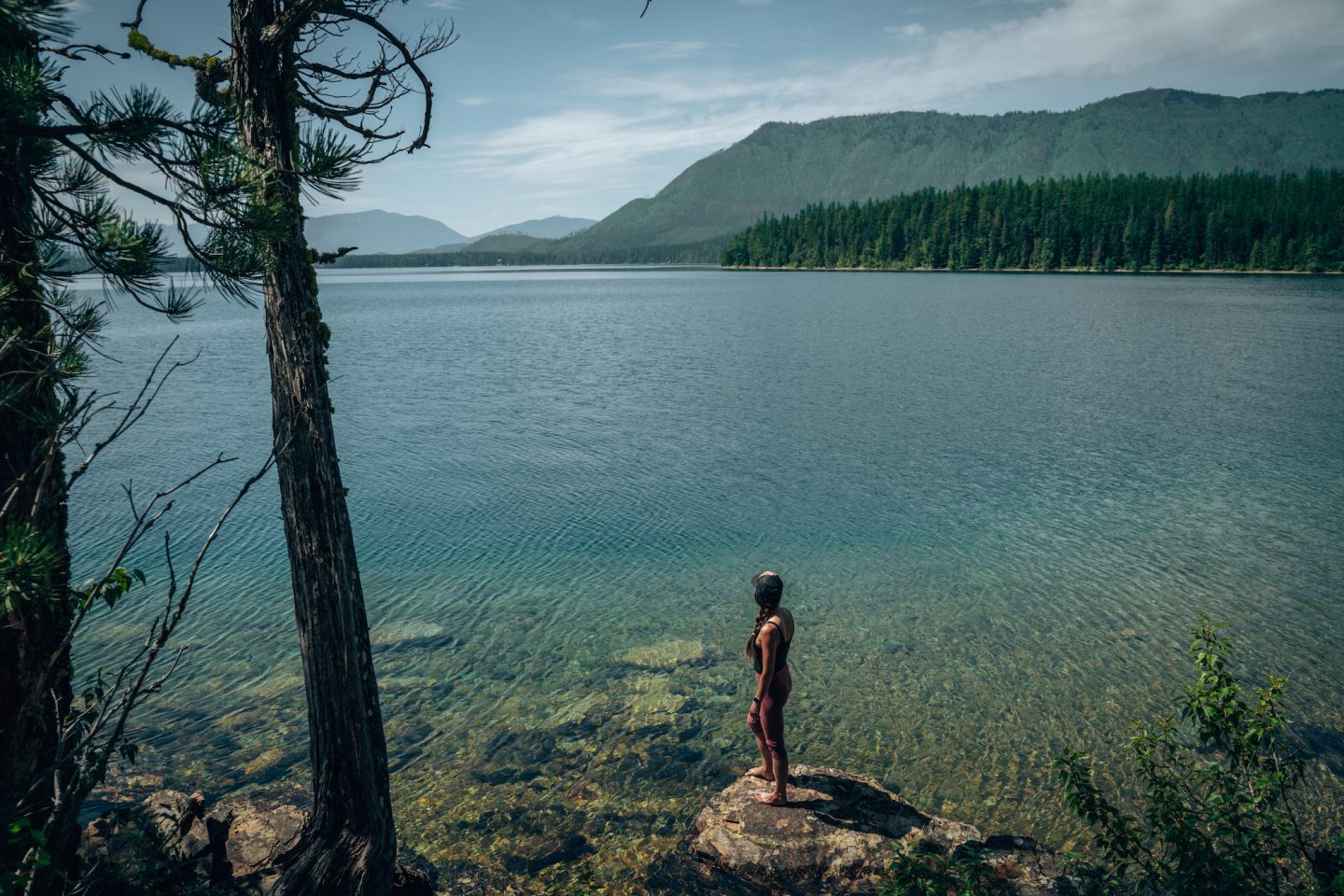
As you venture along the Rock Point Trail, you’ll find yourself surrounded by lush forests and pristine views of Lake McDonald. The trail leads to a stunning rocky outcrop known as Rock Point. A picturesque vantage point to admire the turquoise waters of the lake and the rugged mountains that rise dramatically in the distance.
- DIFFICULTY – Easy to moderate
- LENGTH – 2.0mi / 3.2km out and back
- PET FRIENDLY – No
- SOFT ADVENTURE APPROVED – Yes
TRAIL OF THE CEDARS
The Trail of the Cedars is a short but captivating hike that meanders through an ancient forest of towering cedar and hemlock trees. This wheelchair-accessible trail begins near the Avalanche Creek parking area and offers a delightful adventure for visitors of all ages and abilities.
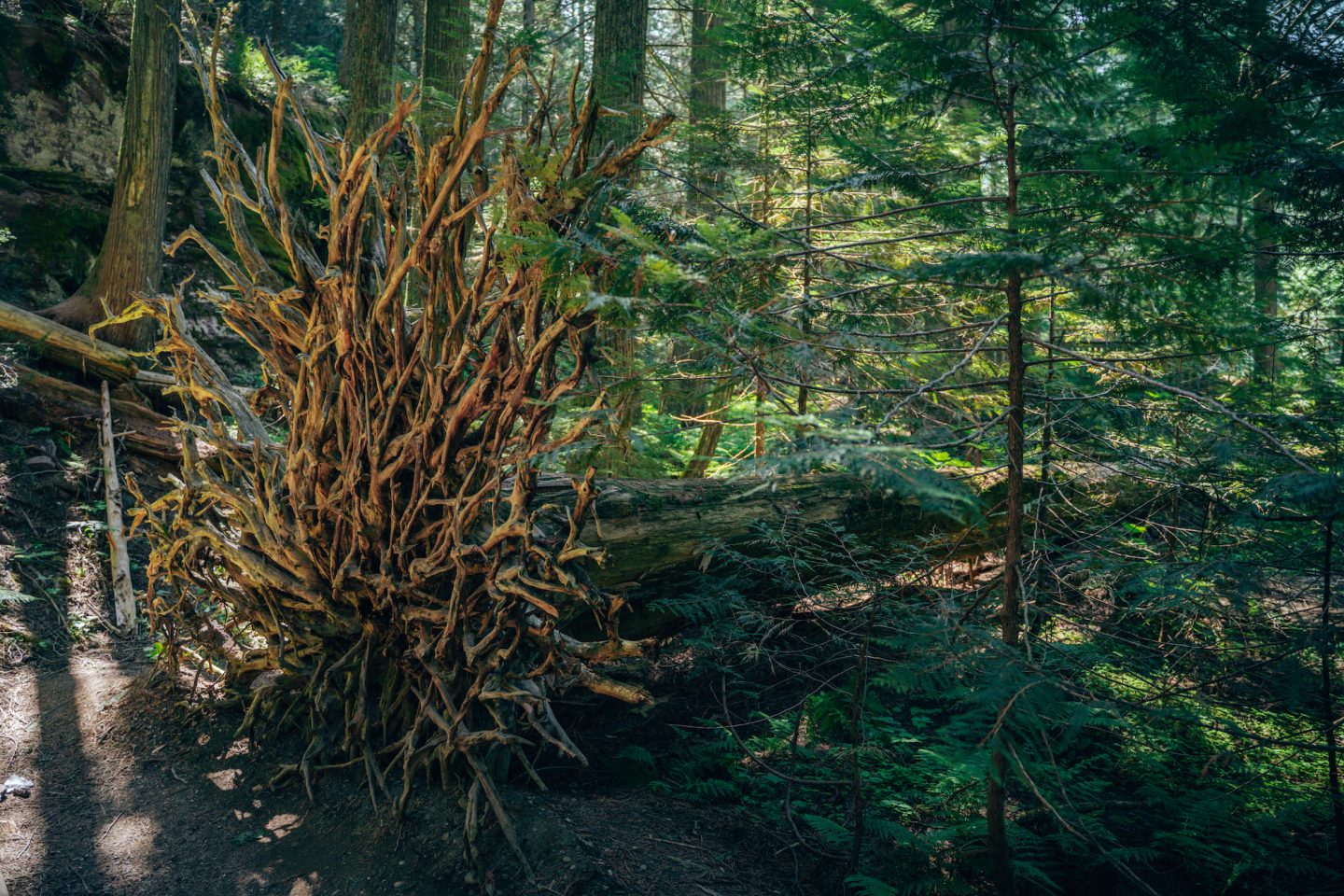
As you step onto the Trail of the Cedars, you’ll be enveloped by the earthy scent of moss and the refreshing coolness of the forest. The trail follows a wooden boardwalk, gently winding its way through the dense vegetation and over the crystal-clear waters of Avalanche Creek.
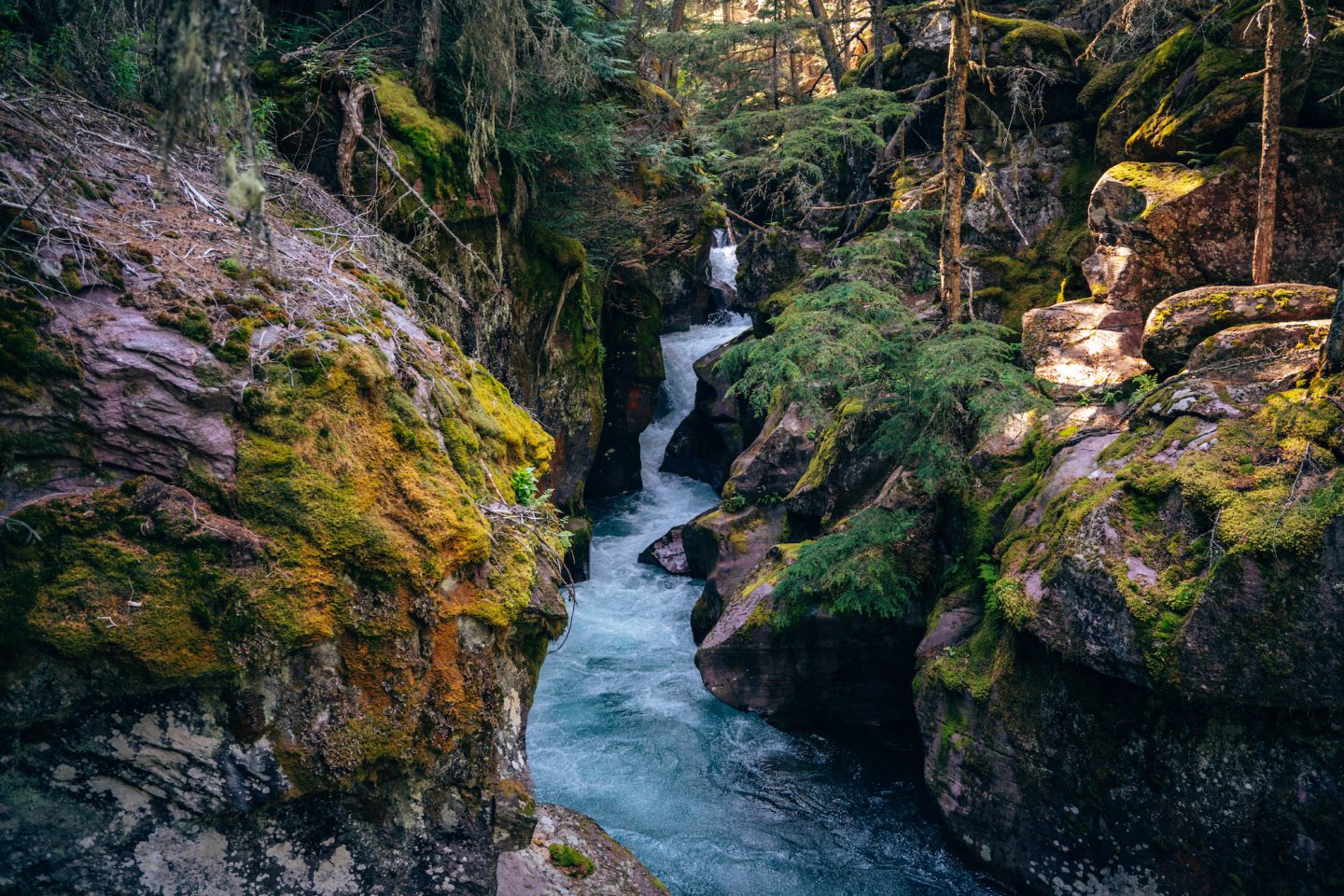
The creek’s turquoise waters and smooth stones create a serene and picturesque setting that is nothing short of magical. Along the way, you’ll encounter impressive cedar and hemlock trees, some of which are hundreds of years old and reach impressive heights. The Trail of the Cedars is ideal for a peaceful and meditative walk, providing an opportunity to connect with nature and appreciate the wonders of Glacier’s pristine wilderness.
- DIFFICULTY – Easy
- LENGTH – 0.9mi / 1.5km loop
- PET FRIENDLY – No
- SOFT ADVENTURE APPROVED – Yes
ST. MARY FALLS & VIRGINIA FALLS
The St. Mary and Virginia Falls Trail in Glacier National Park is a picturesque and rewarding hike that showcases the beauty of cascading waterfalls amidst the lush wilderness. Beginning at the St. Mary Falls Trailhead, the trail follows the banks of St. Mary River, treating hikers to stunning views of the turquoise waters and surrounding mountains.
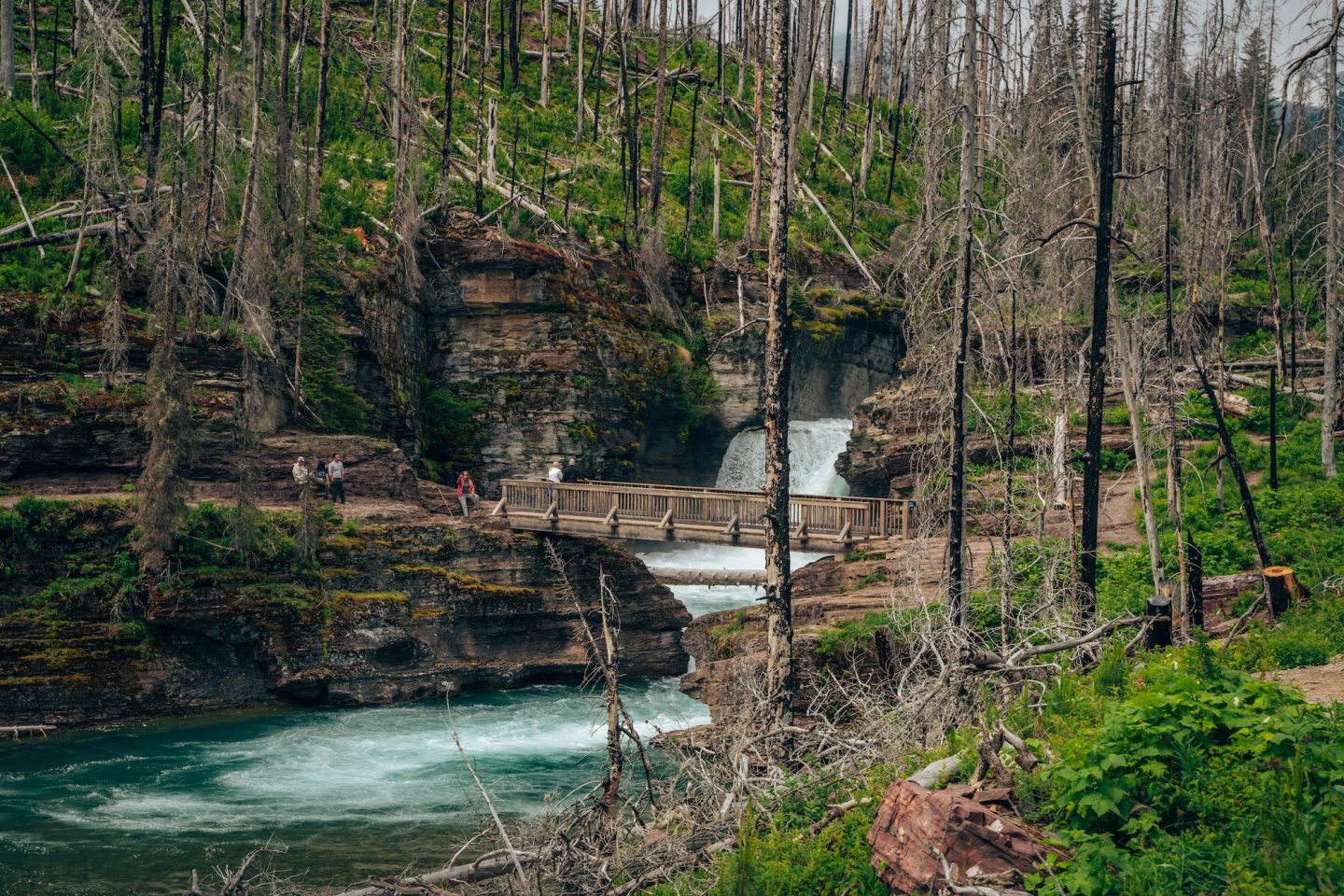
The first highlight of the hike is St. Mary Falls. A two-tiered waterfall that tumbles over rocks, creating a mesmerizing display of rushing water. The trail leads to a viewpoint where you can witness the falls up close and feel the refreshing mist on your face. It’s an ideal spot for photographs and a moment of peaceful contemplation.
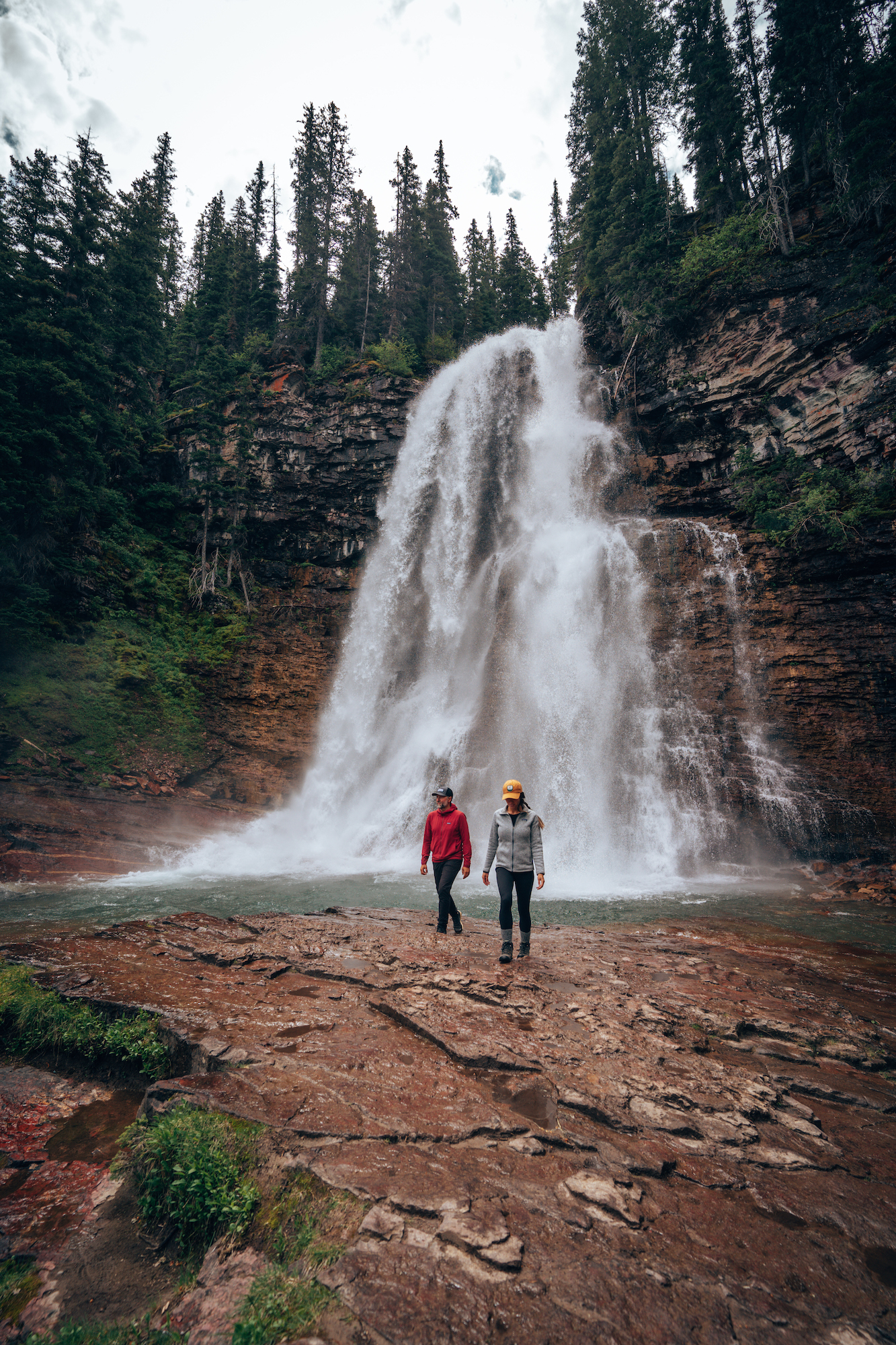
Continuing along the trail, you’ll encounter more captivating scenery as you approach Virginia Falls. The landscape changes as the path meanders through dense forests and over wooden bridges, adding to the adventure. Virginia Falls is a true spectacle, with water dramatically plunging 50 feet into the gorge below. The roaring sound of the falls echoes through the valley, creating an immersive experience that leaves a lasting impression.
- DIFFICULTY – Moderate
- LENGTH – 3.1mi / 4.9km loop
- PET FRIENDLY – No
- SOFT ADVENTURE APPROVED – Yes*
*The hike to St. Mary Falls is a perfect soft adventure, and is about 2mi round trip. From St. Mary Falls, it is roughly an additional 0.6mi to Virginia Falls, which includes some steeper inclines. Our recommendation, it is worth the extra bit to experience Virginia Falls.
JOHN’S LAKE LOOP
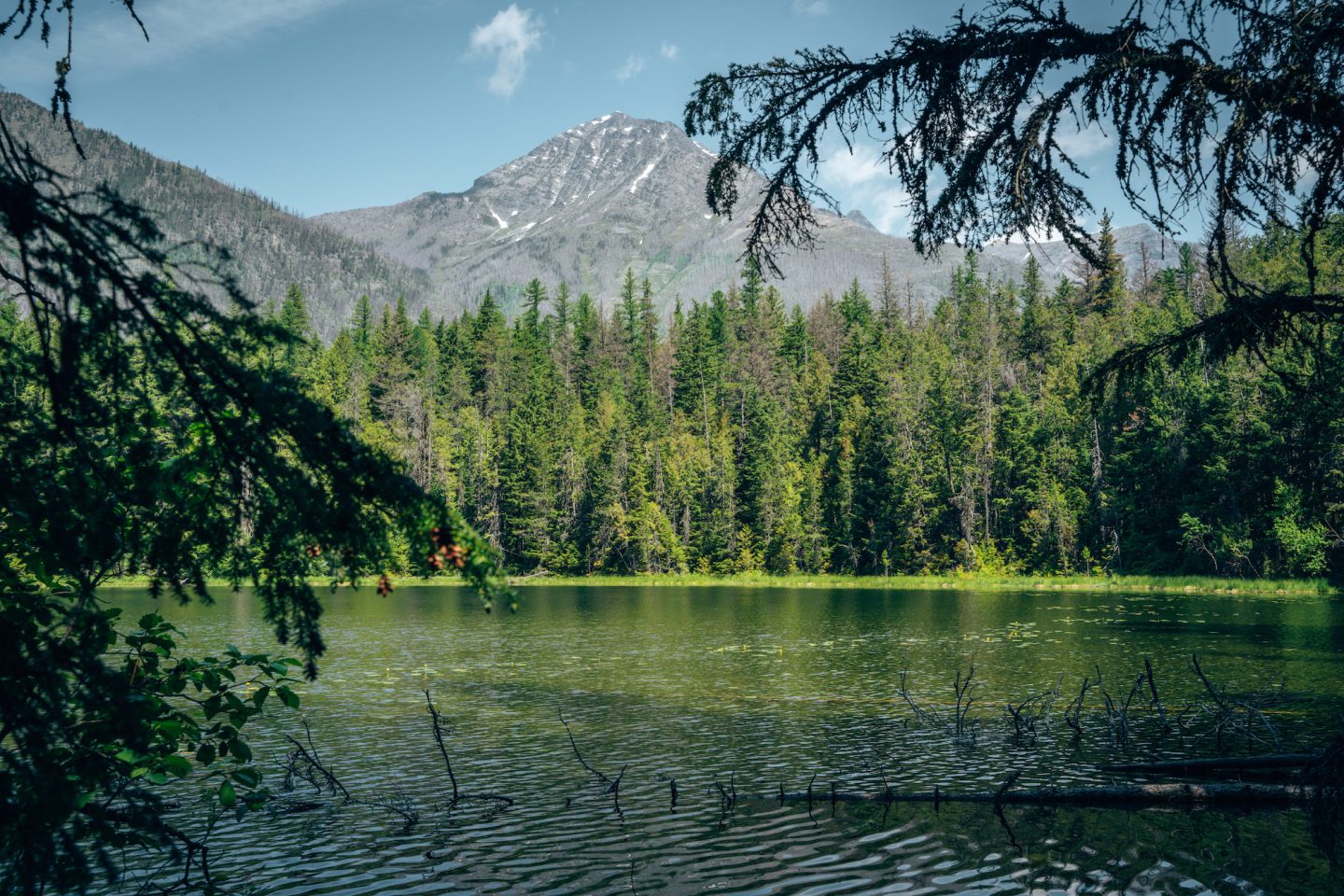
John’s Lake is a hidden gem nestled within the stunning landscapes of Glacier National Park. The hike to John’s Lake is a relatively easy and rewarding adventure. The trail winds through lush forests and offers glimpses of the surrounding mountains, providing hikers with a taste of the park’s diverse beauty. What makes John’s Lake particularly special is its tranquility and the sense of seclusion it offers. Away from the more popular areas of the park, this hidden oasis provides a more intimate connection with nature and a chance to appreciate the untamed beauty of Glacier in a peaceful setting.
- DIFFICULTY – Easy
- LENGTH – 2.0mi / 2.7km
- PET FRIENDLY – No
- SOFT ADVENTURE APPROVED – Yes
SUN POINT
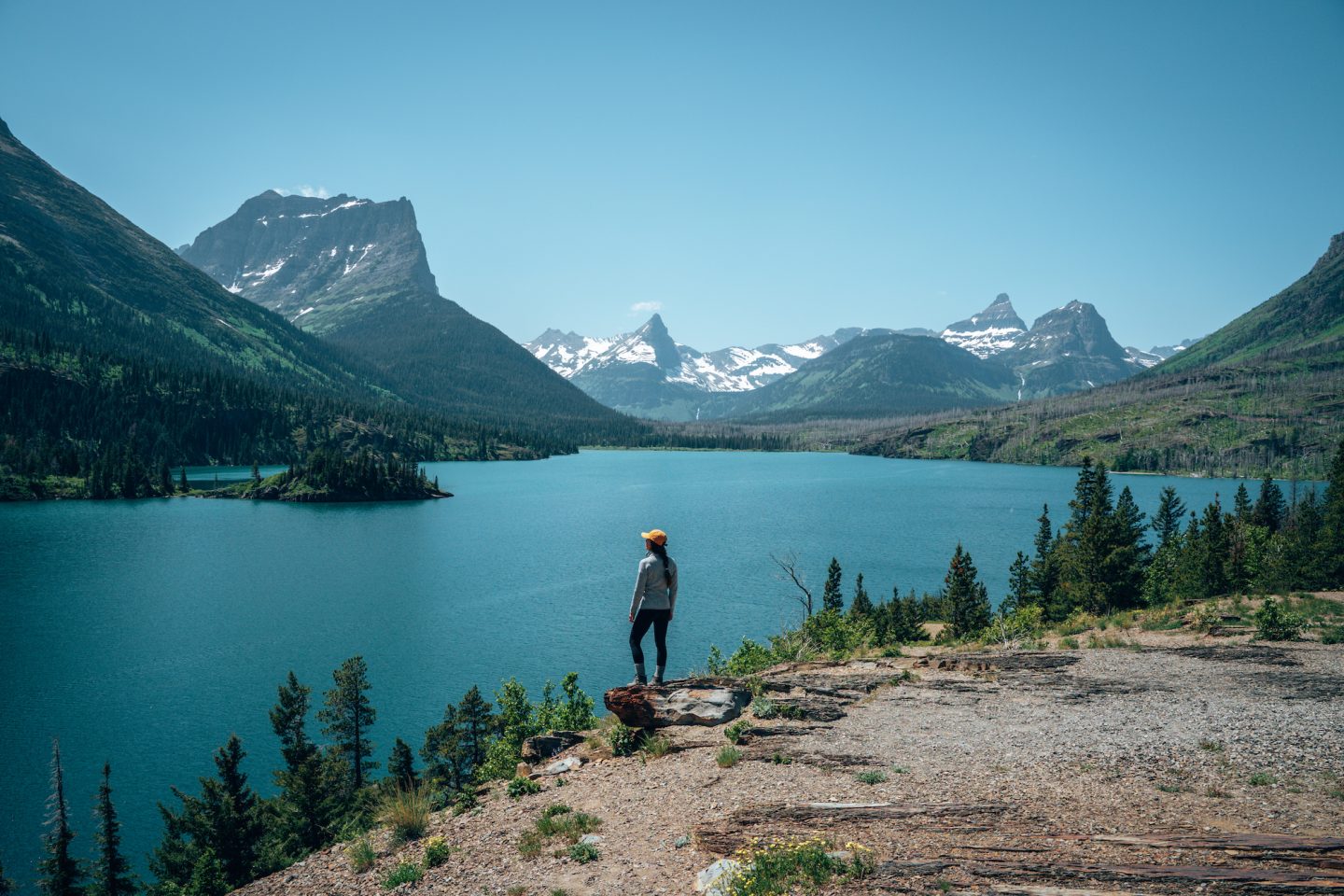
The Sun Point Nature Trail is a short and easy hike that rewards visitors with stunning panoramic views of the park’s iconic landscapes. The trail to Sun Point takes you through a charming forest, gradually ascending to reveal breathtaking vistas of the surrounding mountains, turquoise waters of St. Mary Lake, and the dramatic Wild Goose Island. The trail is less crowded compared to some other popular spots in the park, providing a peaceful and serene ambiance for contemplation and photography.
For a longer adventure, Sunrift Gorge Overlook (Baring Creek/Falls). For a shorter hike, park a the Sun Point Parking lot.
- DIFFICULTY – Easy
- LENGTH – 1.0mi-2.0mi / 1.6km-2.7km
- PET FRIENDLY – No
- SOFT ADVENTURE APPROVED – Yes
OTHER TRAILS & AREAS
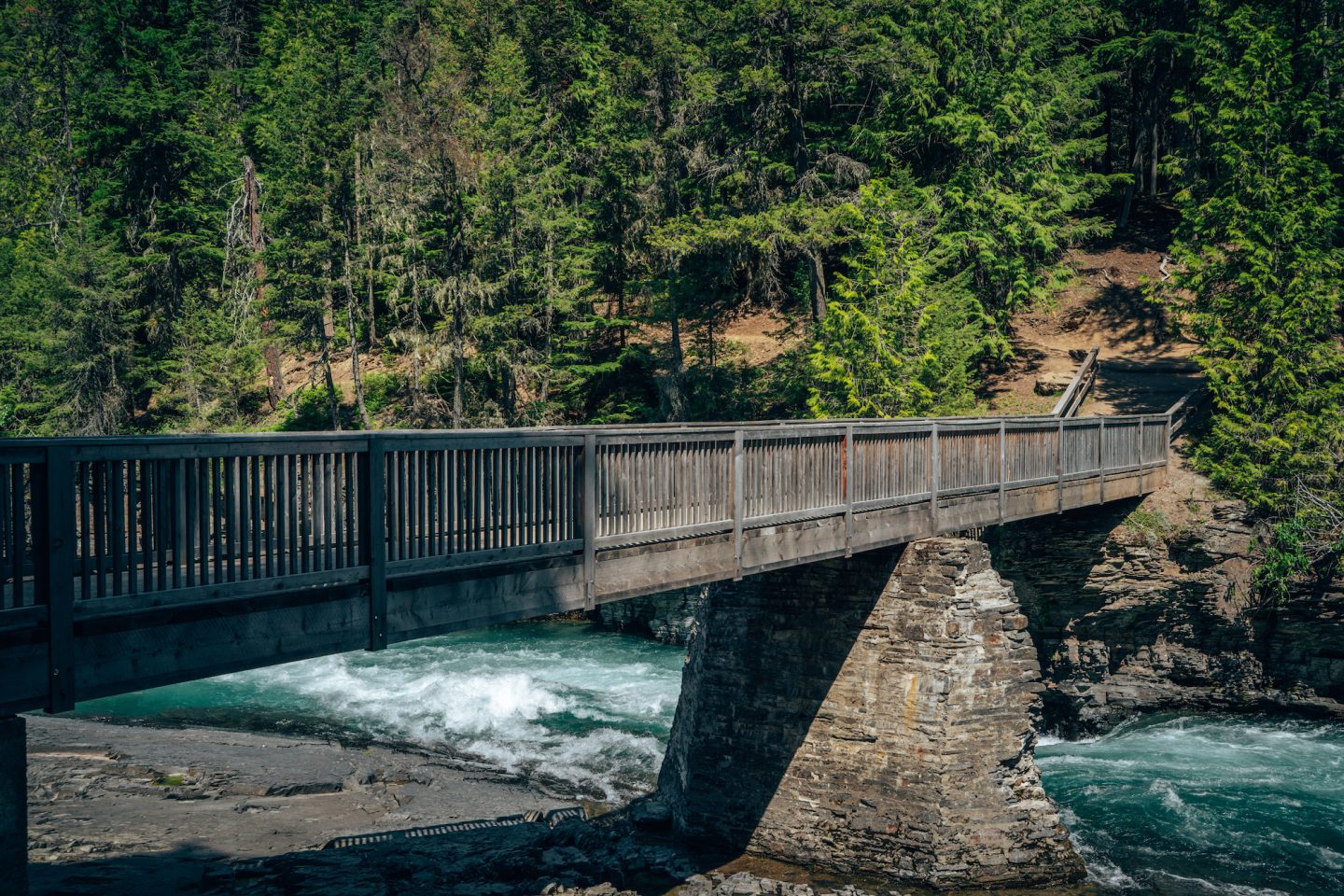
There are a TON of hiking trails in and around Glacier National Park. The four above, and those listed below are the more popular and common trails. But if you’re looking for more or different options, check out the NPS website for more info HERE.
- Hidden Lake Overlook Trail
- Highland Trail
- Grinnell Glacier Trail
- Grinnell Lake Trail
- Iceberg Lake Trail
- Avalanche Lake Trail
- Piegan Pass Trail
STARGAZING
Experience the awe-inspiring night skies of Glacier National Park. The park is designated as an International Dark Sky Park, offering exceptional opportunities for stargazing. Attend one of the park’s astronomy programs or simply find a secluded spot to gaze at the countless stars above. You will not regret it.
BOAT TOURS & WATER ACTIVITIES
Embrace the tranquility of Glacier’s pristine lakes with boat tours. The Lake McDonald Boat Tour and Two Medicine Lake Boat Tour allow you to soak in the beauty of the park from the water’s perspective. Additionally, enjoy kayaking or canoeing on select lakes for a peaceful and immersive experience.
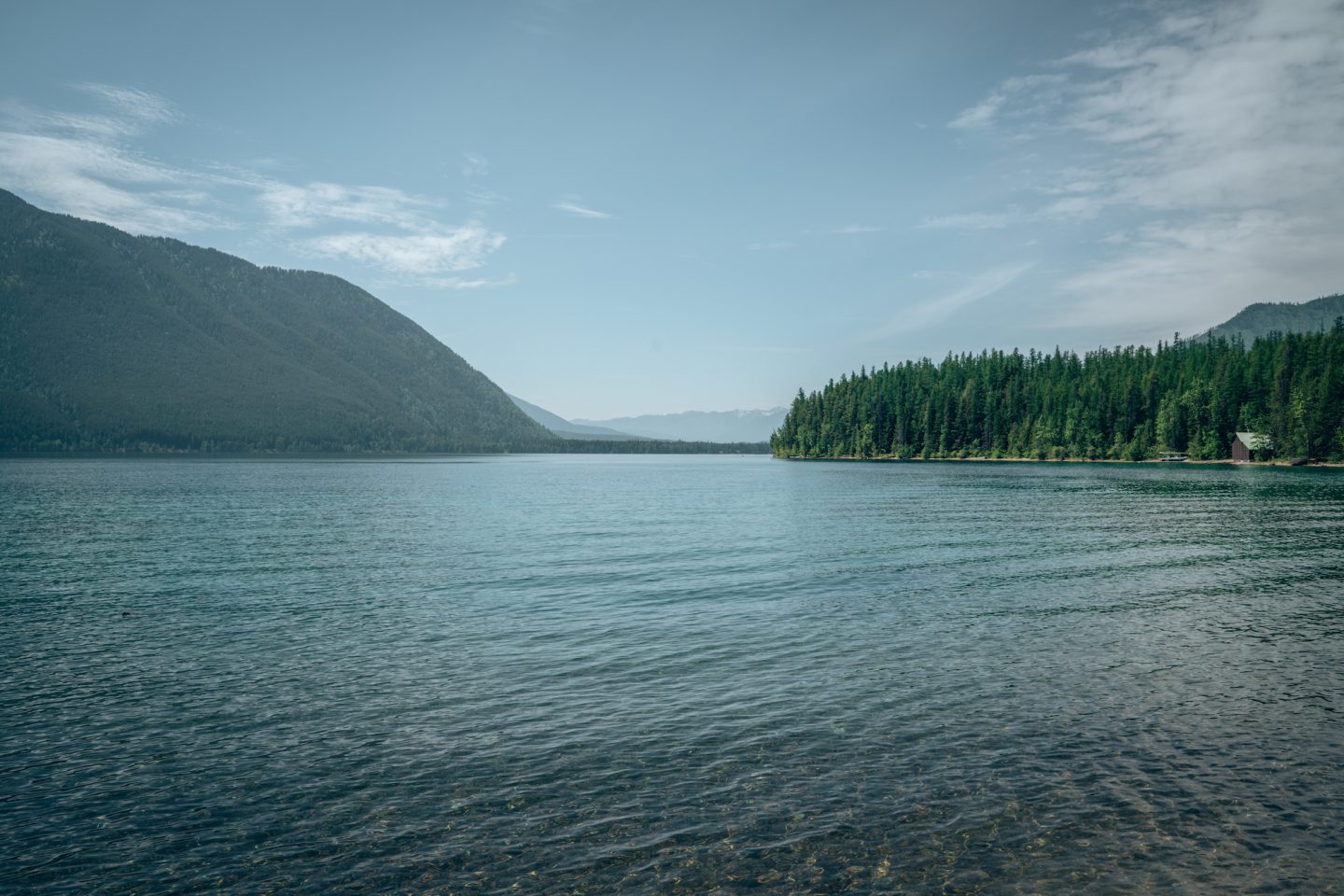
OTHER ACTIVITIES
There are a ton of things to do in this park. And if none of the above catches your interest, you’ll also find ranger led programs, geology talks, wildlife spotting and more. To see all the different things you can do in this park, go HERE.
TINGGLY EXPERIENCES
We mentioned Tinggly above… Looking to do something more fun, or unique? If you aren’t familiar with Tinggly, they are a company based on gifting experiences over stuff. Helicopter tours, sunset cruises, horseback riding, ATV tours, and so so much more. So for that next birthday, or gift-giving holiday, instead of gifting stuff, give the gift of an experience. Memories that will last forever. Click on the banner to check them out, or read our full review of Tinggly HERE.
BEST TIME TO VISIT GLACIER NATIONAL PARK
The best times to visit Glacier National Park largely depend on your preferences and the type of experience you seek. Each season offers its own unique charm and opportunities for exploration:
SPRING
Spring (Late May to June) marks the awakening of Glacier National Park, with wildflowers blooming and waterfalls flowing at their fullest. Though some roads and facilities may still be closed due to snow, this period is perfect for avoiding the summer rush. Spring is also an excellent time for birdwatching as migratory birds return to the park.
- Avg Low temps: 26ºF / -3ºC
- Avg High temps: 47ºF / 8ºC
SUMMER
Summer (June to August) is the peak tourist season when the park is in full bloom. The Going-to-the-Sun Road and other attractions are fully accessible, and most facilities are open. This is the best time for hiking, boat tours, and wildlife viewing, as animals are more active. However, expect large crowds, especially in popular areas. It’s advisable to make accommodation reservations well in advance.
- Avg Low temps: 42ºF / 6ºC
- Avg High temps: 65ºF / 18ºC
FALL
Fall (September to October) brings stunning foliage and a quieter ambiance as the crowds start to thin out. The landscape transforms into vibrant shades of yellow, orange, and red, making it a paradise for photographers. Many of the services and accommodations are still available during this season, but some areas might begin to close in October.
- Avg Low temps: 30ºF / -1ºC
- Avg High temps: 45ºF / 7ºC
WINTER
Winter (November to May) in Glacier National Park is a wonderland for those seeking solitude and winter activities. Many roads and facilities close during this time, but the park transforms into a serene winter wonderland, ideal for cross-country skiing, snowshoeing, and snow-capped scenery. It’s important to note that visiting during winter requires careful planning, as access may be limited due to snow and extreme weather conditions.
- Avg Low temps: 15ºF / -9ºC
- Avg High temps: 30ºF / -1ºC
Overall, the best time to visit Glacier National Park depends on your preferences for crowd levels, activities, and the type of scenery you wish to witness. For those seeking blooming wildflowers and vibrant landscapes, late spring and early fall are ideal. If you prefer warm weather and full access to amenities, summer is the peak season. Winter is perfect for a tranquil snowy retreat, but requires careful preparation and consideration of limited services. Whenever you choose to visit, Glacier National Park promises awe-inspiring beauty and unforgettable experiences.
Our recommendation: If you can visit during the spring months, you’ll find fewer crowds, more luscious greenery, and better temperatures.
You can keep up with park updates HERE.
HOW MUCH TIME IS NEEDED IN GLACIER NATIONAL PARK
The amount of time needed to visit Glacier National Park depends on the depth of your exploration and the activities you plan to undertake. While even a short visit can be rewarding, ideally, you should allocate a minimum of 3 to 5 days to truly experience the park’s highlights and immerse yourself in its beauty. Here are some general ideas of what you might want to do with your time:
DAY TRIP
If you have limited time, you can still get a taste of Glacier National Park. Start the day with a sunrise at Lake McDonald, spend the day driving and exploring the Going-to-the-Sun Road scenic drive and stopping at overlooks to admire the breathtaking vistas. Make stops at popular viewpoints like Logan Pass, where you can take a short hike to Hidden Lake Overlook or stroll along the boardwalk to marvel at the alpine landscapes and wildlife. End your day trip with a spectacular sunset at a scenic overlook. Consider visiting Lake McDonald or Many Glacier for some of the best sunset views in the park. This timeframe will give you a glimpse of the park’s highlights, but you may not have enough time for extensive exploration or multiple hikes.
OVERNIGHT VISIT
With a more than one day, you can delve deeper into the park’s offerings. Start your day either in West Glacier, or St. Mary, driving the Going-to-the-Sun Road visiting and exploring the many overlooks. Enjoy some of the shorter hikes like Trail of The Cedars, Sun Point, or St. Mary Falls or soak off some of the lake views taking a boat tour, or kayaking. On the second day, continue on with your exploration of the other side of the park. No matter which side you start on, or what you do each day, this duration allows for a more relaxed pace and the opportunity to truly appreciate the park’s diverse features.
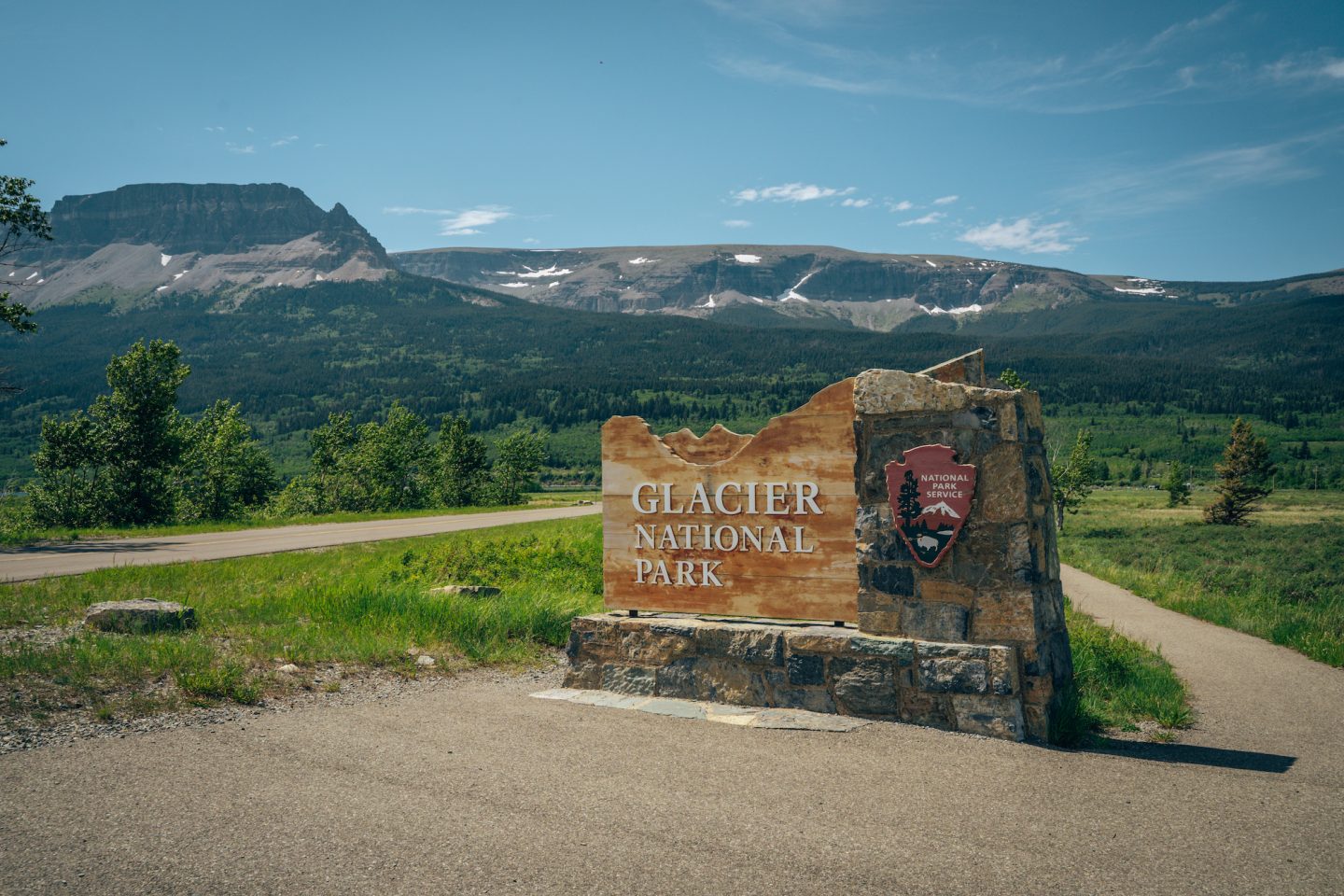
MULTIPLE DAYS
For those seeking a more immersive experience, spending 3-5 days in Glacier National Park is ideal. You can further explore the park’s backcountry trails, embark on longer hikes, and potentially engage in activities like boating or multi-day backpacking trips. It would also allow you experience each area of the park as well. This timeframe allows you to fully immerse yourself in the park’s beauty and tranquility, uncover hidden gems, and truly connect with the natural wonders and rich history of the area.
Ultimately, the amount of time you choose to spend in Glacier National Park depends on your interests, available time, and desired level of exploration. Keep in mind that the park’s vastness and unique attractions can easily captivate visitors for days. Regardless of the duration, make sure to plan ahead. Check trail conditions, and consult the park’s visitor center for the most up-to-date information to make the most of your visit.
OTHER THINGS TO CONSIDER
CELL PHONE SERVICE
Cell phone service inside the park is very spotty, almost non-existent. Subject to your carrier of course. We found that between Verizon and T-Mobile, we had very limited service throughout the park. Before your visit, we’d recommend checking the NPS website for cell and wifi information to help better prepare.
We’d highly recommend downloading offline maps, trail info, and make sure to share your plans and itinerary with someone outside of the park in case of emergency.
And if you’re camping in or around the park, we found that Starlink does work well if you can find an open enough space to reduce the risk of any obstructions.

PET FRIENDLY?
Sadly, Glacier National Park is not the most pet friendly park. This is largely due to the local wildlife and land. Pets are only allowed in the campgrounds, parking lots, paved roads and paved viewpoints areas.
You can find more info on the NPS website HERE.
BEAR COUNTRY
Much of Glacier National Park falls within bear country, with nearly 1,000 bears calling Glacier National Park their home. So it’s not only important to be aware of where bears may be, but also how to keep yourself and the bears safe. This includes being able to identify the two different species of bears that inhabit the area, and knowing what to do if you spot or encounter a bear.
It’s strongly recommended to keep both bear spray and something that makes noise on your person at all time. Something like a small bell to help ward off bears and provide prevention from coming in close contact with them. For information help ensure a safe visit to the park, check out the NPS website HERE.
LEAVE NO TRACE & 10 HIKING ESSENTIALS
This park is full of unique landscapes and fragile environments, both for plant life, and animals alike. So it is incredibly important to practice the 7 Principles Of Leave No Trace. And follow the posted signage and guidelines of the park. If you aren’t familiar with Leave No Trace, here’s a breakdown:
- Plan ahead and prepare
- Travel and camp on durable surfaces
- Dispose of waste properly
- Leave what you find
- Minimize campfire impact
- Respect wildlife
- Be considerate of others
There are additional and more in-depth details of what each of these means on the LNT website, so make sure to take a look at that!
Similarly, because of how harsh the weather conditions can be, and the lack of cell-phone service, it is important to hike with the 10 Essentials of Hiking. If you aren’t familiar, here’s a breakdown:
- NAVIGATION – maps, guides, compass, GPS locator
- HEADLAMP – flashlight and extra batteries or charger
- SUN PROTECTION – body sunscreen, lip sunscreen, and clothing protection
- FIRST AID – including animal and bug repellents
- KNIFE – as well as knife repair kit
- FIRE – matches, lighter, tinder and striker
- SHELTER – tent, cover, or anything to protect and cover you
- FOOD – snacks and extra meal
- WATER – more than the minimum recommended amount
- CLOTHES – enough to handle night-time elements
Interested in knowing what gear we use for all our adventures? Check out our Rock Porch lockers which list all of the gear we use, and where to shop it!
ULTIMATE GUIDE TO GLACIER NATIONAL PARK IN MONTANA
Let us know what you thought of this, if we missed anything, and if you plan on taking a trek to Glacier National Park in Montana at some point, down below in our comments!
And if you’re looking for some other National Park inspiration, check out some of our other articles:
- ULTIMATE GUIDE TO YOSEMITE NATIONAL PARK
- ULTIMATE GUIDE TO CRATER LAKE NATIONAL PARK
- ULTIMATE OREGON ROAD TRIP ITINERARY
- REDWOOD NATIONAL AND STATE PARKS: HOW TO PLAN YOUR VISIT
- 10 NATIONAL PARKS IN THE U.S. YOU PROBABLY DIDN’T KNOW EXISTED
If you aren’t following us on Instagram, then check us out there! And give us a follow as this will be the best place to follow our journey and adventures!
Thanks for stopping by!
Ryan & Katy